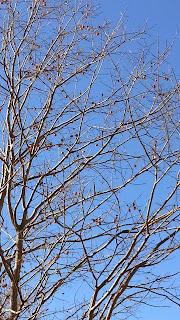While Old Man Winter has some tricks in store for us this winter, Mother Nature still has a few treats for Mid-Atlantic foragers. Recently I found a tree with Persimmons still clinging to the branches. Initially, the trees look a little like the sweet gum maples. But the common persimmon tree, or Diospyros virginiana, is easily identified by the orange, smooth fruit.
The fruit is about 1.5-2" in diameter. While super sweet and date-like in consistency when ripe, the little orange orbs of goodness are remarkably astringent when not at their peak of ripeness. Eat an unripe persimmon just once and you will never do it again! I learned the hard way :-)

Harvesting persimmon fruit is easy: simply pick up the fallen fruit from under the tree. Similar to Pawpaw, the best fruit falls to the ground when fully ripe. The skin may retain a little astringency. I taste a small bit of skin. If I get anything like a chalky taste, but the rest of the fruit tastes good, I peel the skin off. For a trail nibble, pop the whole fruit in your mouth and spit out the seeds.
In addition to a trail snack, persimmons can be preserved. The ripest fruit can be mashed through a potato ricer. The pulp can be added to ice cream, cakes, and my newest favorite way of enjoying the fruit - wine!
The last two years the persimmon harvest has been bountiful. Last year I harvested fruit for over a month, collecting a half gallon in about 5 minutes. This year, unfortunately, the harvest has been quite lousy. By the time the fruit was ripe enough to eat, the trees were almost bare. Bummer. Thus, the title of the post.
I was hoping for another batch or two of persimmon wine this fall, but I will have to wait another year. I think the birds, squirrels, and other denizens of the woods know something about what is coming this winter. Seems like a lot of berries and fruits have been stripped from the trees as soon as they appear.
Have you seen this tree in the wild on a trail or in your neck of the woods?
Don't forget the rules of foraging, especially 100% identification!



You make persimmon wine? What must I do to be invited for wine and dinner?
ReplyDeleteThis sounds as good as home made southern Appalachia peach wine.
I've had home made real nothing artificial no sugar added persimmon bread and pudding After tasting persimmon containing foods as these I could no longer let a ripe persimmon go untasted left alone on the ground ignored like so may native wild edibles.
Mmmm. Peach wine sounds wonderful! I made the persimmon wine this past spring when I came across a forgotten package of persimmons in the freezer that I had collected in the fall. I cooked them and ran them through a food mill to remove the seeds. The wine is a nice straw color of a chardonnay, and quite dry. Maybe from the tannin remaining in the fruit?.. Anyhoo, I added a little additional sugar (evaporated cane juice), and I can't remember what yeast I used, but nothing else. Turned out really well!!
DeleteBTW, I have no problem picking persimmons up off the ground: they are usually much tastier than on the tree.